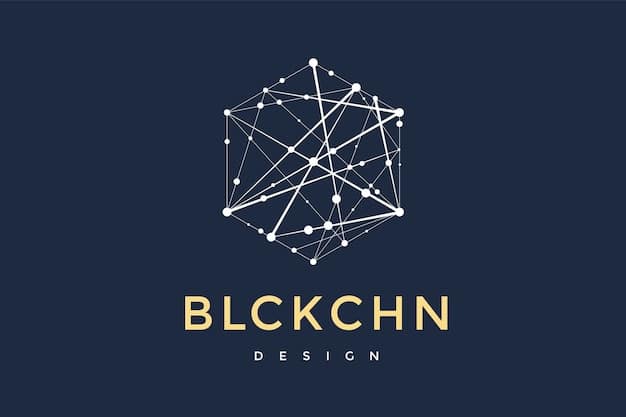Staking Rewards Showdown: Highest Crypto APYs in US (Jan 2025)

Navigating the dynamic landscape of crypto staking, investors in the US are keenly seeking the cryptocurrencies poised to deliver the highest APY in January 2025, a decision hinging on a meticulous balance of technological stability, market capitalization, and projected network adoption for optimal returns.
For those in the United States looking to maximize their passive income from digital assets, understanding which cryptocurrencies offer the highest APYs in January 2025 through staking is paramount. The staking landscape is constantly evolving, with new projects emerging and established ones refining their reward mechanisms, making it crucial for investors to stay informed on the most promising opportunities available within US regulatory frameworks.
Understanding the Mechanics of Staking Rewards
Staking involves locking up cryptocurrency holdings to support the operations of a blockchain network, typically a Proof-of-Stake (PoS) system. In return for their participation, stakers receive rewards, often in the form of additional cryptocurrency. This process is fundamental to the security and efficiency of many modern blockchain networks, acting as an incentive for users to maintain network integrity. The appeal of staking lies in its potential to generate passive income, making it an attractive option for long-term holders of digital assets who wish to grow their portfolios beyond simple price appreciation.
The annual percentage yield (APY) is a crucial metric for evaluating staking opportunities. It reflects the real rate of return earned on a staking account over a year, taking into account the effect of compounding interest. However, APYs can fluctuate significantly due to various factors, including network activity, the total amount of tokens being staked, and changes in the project’s tokenomics. Therefore, a high APY alone does not guarantee a lucrative investment; it must be considered alongside other risk factors and the overall stability of the cryptocurrency.
How APY is Calculated in Staking
The calculation of APY for staking can be complex, influenced by the network’s inflation rate, the number of active validators, and the total supply of staked tokens. Networks are often designed with dynamic reward structures.
- Inflationary Rewards: Many PoS networks issue new tokens as staking rewards, effectively inflating the supply.
- Transaction Fees: Some networks distribute a portion of transaction fees to stakers, adding another layer to the rewards.
- Slashing Penalties: Validators who act maliciously or are offline can face “slashing,” where a portion of their staked tokens is forfeited.
It’s essential for investors to read the whitepaper and documentation of a project to fully understand its staking reward mechanism. Transparent projects typically provide detailed information on how rewards are generated and distributed, offering clarity on the expected APY. The best opportunities are often found in projects that balance high APY with strong fundamentals and a clear roadmap for future development.
Key Factors Influencing Staking APY and Viability in the US
When evaluating staking opportunities for January 2025, several critical factors beyond just the APY come into play, especially for US investors navigating a complex regulatory landscape. These factors collectively determine the viability and attractiveness of a staking proposition, encompassing everything from network stability to regulatory compliance. A thorough assessment of these elements is crucial for making informed investment decisions.
The overall health and activity of a blockchain network directly influence its staking rewards. A network with robust development, high transaction volume, and a growing user base is more likely to sustain attractive APYs. Conversely, projects with dwindling activity or security concerns may see their staking rewards diminish or become unsustainable. It’s not just about the current APY but the project’s long-term potential.
The liquidity of a staked asset is another important consideration. Some staking mechanisms require tokens to be locked up for a specific period, making them illiquid during that time. While this can sometimes lead to higher rewards, it also means investors cannot react quickly to market changes. Projects that offer flexible unstaking options or provide liquid staking derivatives (LSDs) address this concern, offering a more balanced approach to risk and return.
Regulatory Landscape and its Impact
For US investors, the regulatory environment is a paramount concern. The Securities and Exchange Commission (SEC) and other regulatory bodies continue to scrutinize cryptocurrency projects, and staking services are no exception. Compliance with existing and forthcoming regulations can significantly impact which cryptocurrencies are available for staking in the US and the terms under which they are offered. Investors should prioritize projects that demonstrate a clear commitment to regulatory compliance.
Technological Stability and Security
The underlying technology of a blockchain is critical. Networks that are secure, decentralized, and scalable are generally more reliable for staking. Vulnerabilities in smart contracts, potential for network attacks, or centralization risks can jeopardize staked assets and future rewards. Thorough research into the project’s technical architecture, audit reports, and developer community engagement is crucial. A strong development team and a well-tested protocol are indicators of long-term viability.
Top Contenders for Highest Staking APY in January 2025 (US-Available)
Identifying the specific cryptocurrencies that will offer the absolute highest APY in January 2025 is speculative, as market conditions and network dynamics are constantly shifting. However, based on current trends, technological maturity, and projected developments, several established and emerging projects show strong potential to be among the top contenders for US investors. These projects typically combine robust network fundamentals with attractive reward mechanisms, appealing to those looking for significant passive income.
It’s important to differentiate between projects available through centralized exchanges that offer staking services and those where users can stake directly on the network. While centralized exchanges often simplify the staking process, they may offer lower APYs and introduce counterparty risk. Direct staking provides full control but requires more technical knowledge. For the purposes of this discussion, we are considering possibilities across both paradigms, focusing on accessibility for US citizens.
Several factors will heavily influence which cryptos provide the best APY by 2025. These include protocol upgrades, shifts in network participation, and broader market sentiment. Projects with strong governance frameworks allowing for swift adaptation to these changes are likely to maintain competitive APYs. Additionally, protocols fostering a vibrant ecosystem of DApps and users tend to see increased demand for their native tokens, positively impacting staking yields.
Ethereum (ETH) – Post-Merge Evolution
Despite its lower APY compared to some altcoins, Ethereum staking remains a cornerstone for many investors due to its market capitalization, established ecosystem, and ongoing network upgrades. Post-merge, staking ETH offers security and an expected steady return, bolstered by potential EIP-1559 fee burning. While not the “highest” APY, its stability and importance in the crypto world make it a strong contender for reliable returns in January 2025. The increasing number of staked ETH and the developing liquid staking ecosystem indicate a mature and robust staking environment.

Cardano (ADA) – Decentralized and Sustainable
Cardano’s (ADA) Proof-of-Stake mechanism, Ouroboros, is known for its security and decentralization. Staking ADA is highly accessible, allowing users to delegate their tokens to stake pools without locking them up, ensuring liquidity. While
ADA’s APY historically ranges moderately, its significant development roadmap towards scalability and smart contract capabilities suggests continued network growth and potentially stable or increasing rewards. Its scientific approach to blockchain development and strong community support contribute to its long-term viability.
Polkadot (DOT) – Interoperable Blockchain Ecosystem
Polkadot (DOT) stands out with its parachain model, enabling diverse blockchain networks to connect and communicate. Staking DOT involves participating in network governance and securing the relay chain. Polkadot aims for scalability and interoperability, which could drive demand for its token and, consequently, its staking APY. Its active development and growing ecosystem of parachains could position it as a top performer for returns in 2025, although it does have a bonding period that affects immediate liquidity. The unique Nominated Proof-of-Stake (NPoS) mechanism allows for a larger number of validators, enhancing decentralization.
Solana (SOL) – High Performance and Growing Ecosystem
Solana (SOL) is renowned for its high transaction throughput and low fees, attracting a rapidly expanding ecosystem of DApps and users. Staking SOL contributes to the network’s security, and its APY can be competitive, though it often involves delegating to validators. The continued expansion of Solana’s ecosystem and its potential for mass adoption could maintain strong staking rewards. However, investors should be mindful of its historical network stability issues, though these are continually being addressed by the development team. The robust developer tools and vibrant community are strong indicators of future growth.
The Evolving Landscape of Liquid Staking in the US
Liquid staking has emerged as a significant innovation in the cryptocurrency space, addressing one of the primary drawbacks of traditional staking: illiquidity. In liquid staking, users receive a liquid staking derivative (LSD) token representing their staked assets. This LSD token can then be used in various decentralized finance (DeFi) protocols, such as lending, borrowing, or providing liquidity, while the original asset remains staked and earning rewards. This dual utility aims to maximize capital efficiency for stakers, allowing them to earn staking rewards and simultaneously participate in other DeFi activities.
For US investors, the availability and regulatory treatment of liquid staking protocols are becoming increasingly important. While liquid staking enhances flexibility and potential returns, it also introduces additional layers of risk. These risks include smart contract vulnerabilities in the liquid staking protocol, the potential de-peg of the LSD token from its underlying asset, and the overall security of the DeFi ecosystem where the LSD is utilized. Therefore, a careful evaluation of the protocol’s security audits and decentralization level is essential.
The regulatory clarity surrounding LSDs in the US is still evolving. Investors need to be aware that some LSDs might be viewed differently by regulatory bodies compared to the underlying staked asset. As the market matures, we can expect more guidance, but for January 2025, vigilance regarding regulatory changes and project compliance will be paramount. Choosing reputable and audited liquid staking providers is crucial for mitigating potential regulatory and technical risks.
Benefits of Liquid Staking
The primary benefit is enhanced capital efficiency. By receiving an LSD, investors don’t have to choose between earning staking rewards and participating in DeFi.
- Increased Flexibility: LSDs can be traded, sold, or used as collateral without unstaking the underlying asset.
- Compounding Returns: Opportunities to earn additional yield on LSDs in other DeFi protocols.
- Reduced Opportunity Cost: Avoids the dilemma of locking up assets for staking, freeing up capital for other investments.
Despite the advantages, it’s critical to understand that liquid staking adds complexity and expands the risk profile. Investors must perform thorough due diligence on both the underlying staking protocol and the liquid staking solution itself. The promise of higher aggregate APYs needs to be weighed against these additional risks, making it suitable for more experienced users.
Evaluating Risks and Rewards: Beyond Just APY
While the allure of high APY is a powerful motivator for staking, a prudent investment strategy demands a comprehensive evaluation of associated risks and potential rewards. Focusing solely on the advertised APY can be misleading, as higher returns often correlate with higher risks. For US investors, this assessment is further complicated by the evolving regulatory landscape and the inherent volatility of the cryptocurrency market. A balanced perspective that considers both the upside and downside is essential for sustainable passive income generation.
The future value of a staked asset is perhaps the most significant risk factor. Even if a cryptocurrency offers a phenomenal APY, a drastic drop in its market price can quickly negate any staking rewards. Therefore, the long-term fundamentals of the project, including its utility, adoption, and competitive advantages, are critical. Investing in projects with strong use cases and a clear path to widespread adoption is generally less risky than chasing short-term high-APY opportunities with speculative assets.
Regulatory changes, particularly in the US, pose another substantial risk. New legislation or enforcement actions could impact the availability of certain staking services or even deem specific cryptocurrencies as unregistered securities, with significant repercussions for investors. Staying informed about the regulatory environment and diversifying across various projects can help mitigate these risks.
Tokenomics and Inflationary Pressures
Understanding a project’s tokenomics is crucial. High APYs might sometimes be driven by an inflationary token supply, where new tokens are constantly minted to reward stakers. While this can provide attractive short-term yields, it can also dilute the value of existing tokens in the long run, eroding overall returns. A sustainable staking model typically balances rewards with the token’s utility and deflationary mechanisms, if any.

Security Vulnerabilities and Smart Contract Risks
Staking often involves interacting with smart contracts, which can have vulnerabilities. Exploits, bugs, or malicious attacks on these contracts could lead to the loss of staked assets. Opting for protocols with a proven track record, undergoing regular security audits by reputable firms, and having robust bug bounty programs significantly reduces this risk. Decentralized and open-source projects generally offer greater transparency and community oversight, which can contribute to enhanced security.
Strategic Approaches for Maximizing Staking Returns in 2025
For US investors looking to maximize their staking returns in January 2025, adopting a strategic and informed approach is paramount. This involves not only selecting cryptocurrencies with competitive APYs but also employing techniques to optimize those returns while managing risk. The dynamic nature of the crypto market necessitates continuous learning and adaptation, moving beyond a simple “set it and forget it” mentality.
One key strategy involves diversification. Instead of putting all capital into a single high-APY asset, spreading investments across several reputable projects can mitigate specific project risks. This approach ensures that if one project underperforms or faces technical issues, the overall portfolio remains relatively stable. Diversification should also consider different types of projects and blockchain ecosystems to further spread exposure.
Another crucial aspect is active management and rebalancing. Market conditions and protocol mechanics can change, impacting APYs and token values. Regularly reviewing your staked assets, assessing current APYs, and making adjustments based on new information or strategic shifts can help maintain optimal returns. This might involve moving capital between different staking opportunities or unstaking assets during periods of extreme volatility.
Research and Due Diligence
This cannot be overstated. Before staking any asset, conduct thorough research into the project’s fundamentals, team, technology, community, and tokenomics. Understand the potential risks, including regulatory concerns, technical vulnerabilities, and market volatility. Rely on multiple reputable sources and critically evaluate information. This deep dive into each potential investment will invariably improve your decision-making.
Understanding Tax Implications
For US investors, understanding the tax implications of staking rewards is crucial. Staking rewards are generally considered taxable income at the time they are received and at their fair market value in US dollars. Additionally, if the staked asset appreciates in value before being sold, it may incur capital gains tax. Consulting with a tax professional specializing in crypto is highly recommended to ensure compliance and optimize tax efficiency. Ignoring these aspects can lead to significant penalties.
Utilizing Staking Pools and Delegated Staking
For those with smaller holdings or less technical expertise, participating in staking pools or delegating tokens to experienced validators can be a viable strategy. These services typically handle the technical complexities of running a validator node, allowing individual investors to earn rewards without the need for extensive hardware or software setup. While pools may charge a small fee, the convenience and enhanced reliability can outweigh the costs, making staking accessible to a broader audience.
Looking Ahead: Staking Trends and Innovations for January 2025
As we approach January 2025, the staking landscape is set not only to evolve but to potentially undergo significant transformations driven by technological advancements, increasing regulatory scrutiny, and a growing demand for sustainable passive income streams. Understanding these emerging trends and innovations is vital for US investors seeking to position themselves advantageously in this dynamic sector. The future of staking promises greater sophistication, more integration with traditional finance, and a stronger emphasis on sustainability.
One of the most prominent trends is the continued maturation and adoption of liquid staking solutions. As more institutional and retail investors seek flexibility, liquid staking tokens (LSDs) will likely see increased utility and acceptance across a wider range of DeFi protocols. This expansion will also push for greater standardization and security audits within the liquid staking ecosystem, enhancing overall user confidence. Expect more robust infrastructure supporting LSDs.
The regulatory environment is also a major shaping force. By 2025, we might see more defined guidelines and frameworks for staking and LSDs in the US, providing clearer pathways for institutional participation and further integrating crypto staking into traditional financial advisories. While this could bring increased compliance burdens, it also presents an opportunity for wider adoption and legitimacy for compliant projects. The focus on consumer protection and market integrity will intensify.
Rise of Restaking Protocols
Emerging concepts like restaking (e.g., EigenLayer on Ethereum) are set to create new layers of yield opportunities. Restaking allows stakers to reuse their staked ETH to secure other decentralized applications and protocols, earning additional rewards. This innovation could significantly amplify capital efficiency but also introduces new layers of complexity and potential systemic risks that investors will need to carefully assess.
Increased Focus on Environmental, Social, and Governance (ESG) in Staking
The growing importance of ESG factors in traditional investments is beginning to influence the crypto space. Staking projects demonstrating strong commitments to environmental sustainability (e.g., energy efficiency), social impact, and good governance practices might gain favor among a new wave of conscientious investors. Projects actively working to reduce their carbon footprint or promote decentralization could see increased adoption.
Interoperable Staking Across Chains
As blockchain ecosystems become more interconnected, solutions enabling interoperable staking—where assets from one chain can be easily staked on another or cross-chain liquid staking—will likely gain traction. This could unlock liquidity across diverse networks and offer more varied yield opportunities, requiring sophisticated cross-chain bridge technology and security protocols to ensure safety and efficiency.
| Key Insight | Brief Description |
|---|---|
| 📊 Dynamic APY | Staking APY in Jan 2025 will depend on network activity, total staked, and project tokenomics. |
| 🇺🇸 Regulatory Focus | US compliance and evolving regulations are critical for staking availability and terms. |
| 💧 Liquid Staking | LSDs offer capital efficiency but introduce additional smart contract and de-peg risks. |
| 🛡️ Risk Management | Diversification, active management, and tax awareness are vital for maximizing returns. |
Frequently Asked Questions About Staking Rewards
Several factors influence staking APY, including the network’s inflation rate, the total percentage of tokens being staked, the number of active validators, and the protocol’s specific reward mechanism. Network health, development progress, and market demand for the token also play a significant role in sustaining APY.
The legality of staking in the US is complex and evolving. While staking itself isn’t explicitly illegal, the regulatory classification of certain cryptocurrencies or staking services can vary. Investors should stay informed about SEC guidelines and choose reputable platforms adhering to US regulations to mitigate potential legal risks.
Liquid staking involves receiving a liquid staking derivative (LSD) token after staking, allowing users to earn staking rewards while simultaneously using the LSD in DeFi. Traditional staking locks up assets, making them illiquid. Liquid staking offers greater capital efficiency but introduces additional smart contract and de-peg risks.
The primary risks include price volatility of the staked asset, smart contract vulnerabilities, potential slashing penalties for validator misbehavior, and illiquidity during lock-up periods. Regulatory changes in the US, inflationary pressures from tokenomics, and platform-specific risks (for centralized services) also need careful consideration.
To minimize risks, conduct thorough due diligence on projects, diversify your staked assets across multiple cryptocurrencies and protocols, and understand tax implications. Utilize reputable staking providers, stay updated on regulatory developments, and consider projects with strong fundamentals over those solely boasting unsustainably high APYs for short-term gains.
Conclusion
Navigating the competitive landscape of crypto staking rewards in the US for January 2025 demands a strategic blend of keen financial insight, thorough due diligence, and an informed understanding of both market dynamics and regulatory frameworks. While the allure of high APY is undeniable, sustainable success hinges on a holistic assessment that prioritizes network stability, security, project fundamentals, and the evolving trends like liquid staking. By focusing on diversification, prudent risk management, and continuous education, US investors can position themselves effectively to leverage staking as a powerful tool for generating passive income within the burgeoning digital asset economy.





